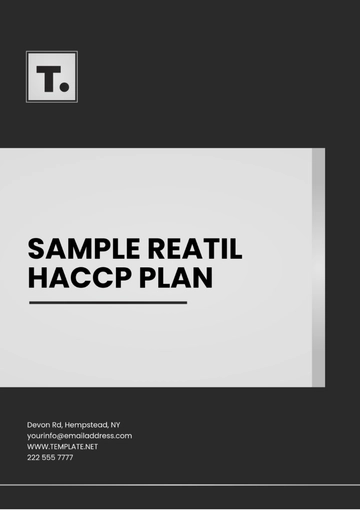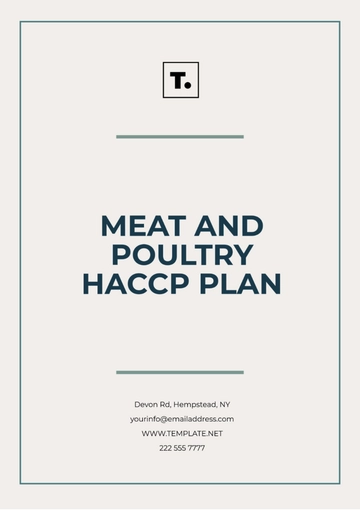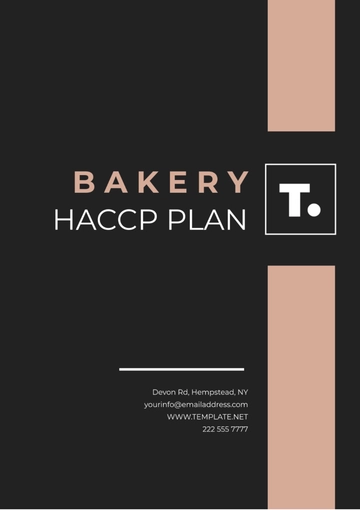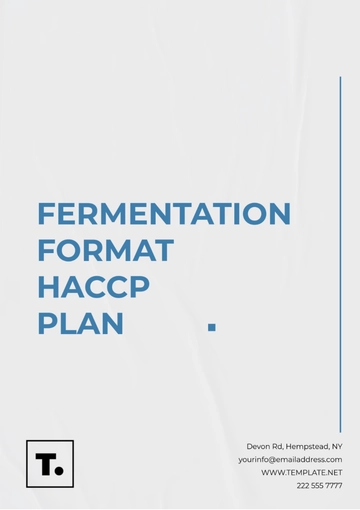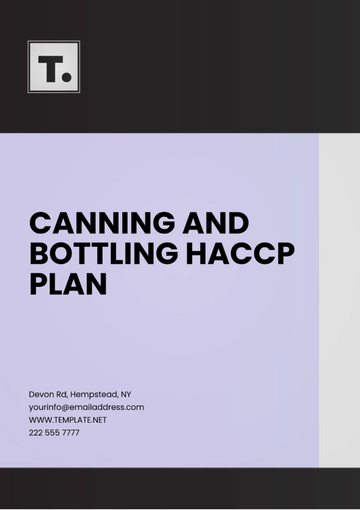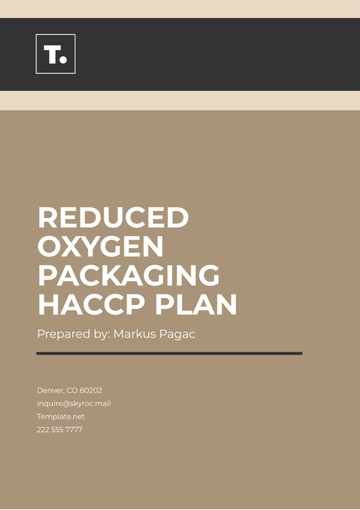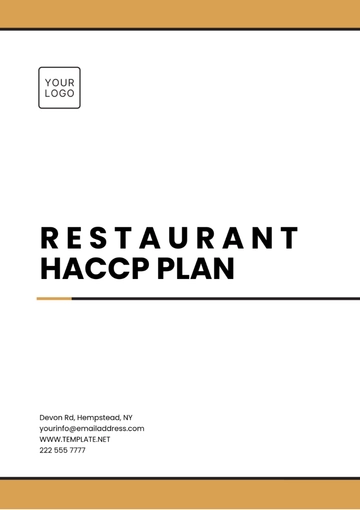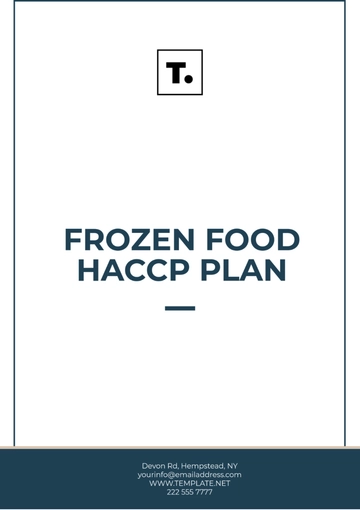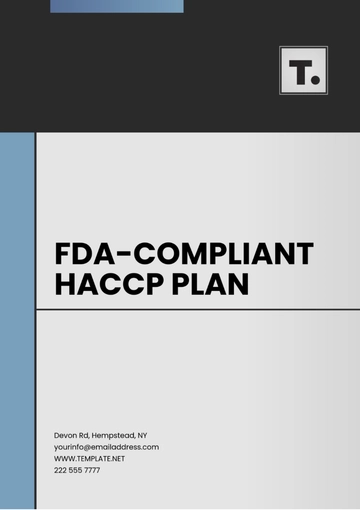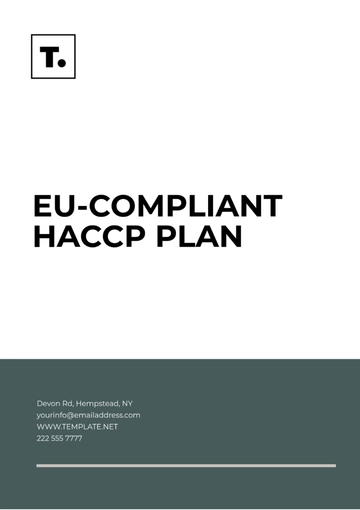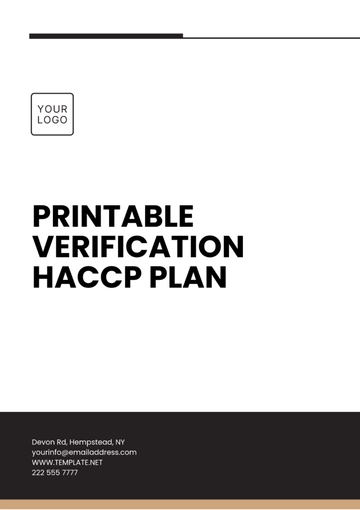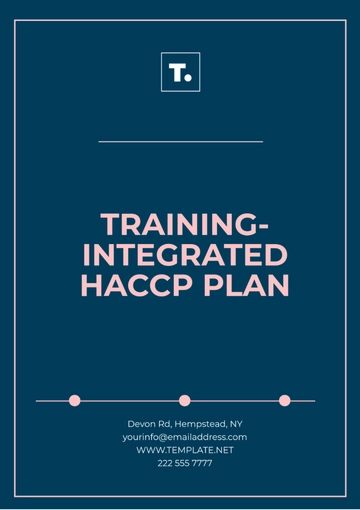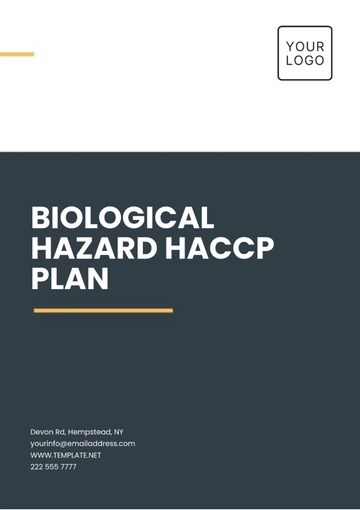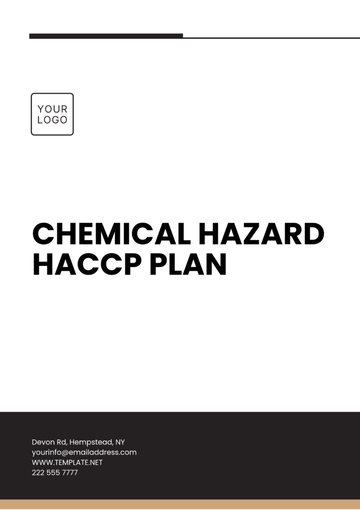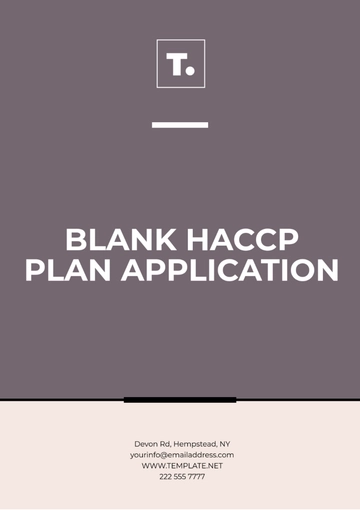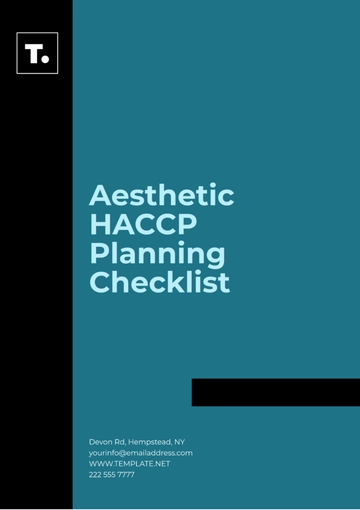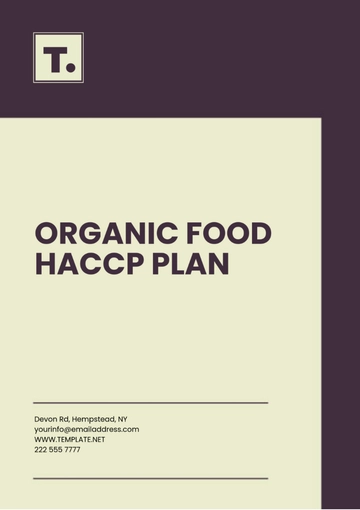Free Printable Verification HACCP Plan

Date: May 1, 2060
Prepared by: [YOUR NAME]
I. Introduction and Purpose
The purpose of this plan, known as the Hazard Analysis and Critical Control Points (HACCP) plan, is to meticulously identify, thoroughly evaluate, and effectively control any potential hazards related to food safety. The primary goal of this comprehensive plan is to guarantee the safety of food products by systematically preventing, significantly reducing, or eliminating any potential risks that may arise throughout the entirety of the production process.
II. Scope
This Hazard Analysis and Critical Control Points (HACCP) plan encompasses all stages of the production process, with a particular emphasis on the various aspects of food product handling, preparation, and storage. This plan is applicable to the entirety of the products that are manufactured within our facility, ensuring that they adhere to established food safety regulations and standards.
III. Team Composition
The success of this HACCP plan relies on a dedicated team:
Project Manager: Oversees the HACCP implementation.
Food Safety Specialist: Identifies hazards and develops control measures.
Production Supervisor: Ensures adherence to the plan during operations.
Quality Assurance Officer: Monitors CCPs and verifies compliance.
Engineering Support: Maintains equipment to support food safety.
IV. Hazard Analysis
Step | Potential Hazard | Source |
|---|---|---|
Receiving | Biological contamination | Raw materials |
Processing | Chemical contamination | Cleaning agents |
Storage | Physical contamination | Environmental factors |
V. Critical Control Points (CCPs)
CCP | Control Measure |
|---|---|
Cooking | Maintain internal temperature |
Cooling | Monitor cooling times |
Packaging | Ensure seal integrity |
VI. Monitoring Procedures
Effective monitoring is vital to ensure that all CCPs remain within established safety limits. The following monitoring procedures will be implemented:
Temperature Checks: Conduct hourly temperature checks using calibrated thermometers during the cooking and cooling phases. Record temperatures in a log for traceability.
Cooling Monitoring: Document cooling times and temperatures at specified intervals, ensuring compliance with cooling protocols.
Packaging Inspections: Perform daily visual inspections of the packaging process and machinery to verify the integrity and safety of sealed packages.
VII. Corrective Actions
Prompt corrective actions are essential when deviations from established limits are identified. The following procedures will be followed:
Isolation of Affected Products: Identify and quarantine any products that are found to be non-compliant to prevent further distribution and consumption.
Investigation of Deviations: Conduct a thorough investigation to determine the root cause of the deviation, involving relevant team members as necessary.
Implementation of Corrective Measures: Implement corrective actions tailored to address the specific issue, which may include retraining staff, revising procedures, or enhancing equipment maintenance.
Documentation of Actions: Maintain detailed records of all corrective actions taken, including the nature of the deviation, investigation findings, and measures implemented.
VIII. Verification Procedures
Verification activities are critical to ensuring the ongoing effectiveness of the HACCP system. The following verification procedures will be implemented:
Weekly Record Review: Conduct weekly reviews of monitoring records and CCP data to ensure compliance and identify trends that may require action.
Quarterly Internal Audits: Perform quarterly internal audits to assess compliance with the HACCP plan, identify areas for improvement, and ensure that all procedures are being followed correctly.
Microbiological Testing: Submit product samples for external microbiological testing semi-annually to verify the effectiveness of food safety measures and ensure that products meet safety standards.
IX. Documentation and Record Keeping
Comprehensive documentation is essential for maintaining compliance and ensuring transparency. Key practices include:
Record Maintenance: Keep thorough records of CCP monitoring, test results, corrective actions taken, and any other relevant documentation.
Secure Storage: Store all records securely for a minimum of one year, ensuring easy access for audits and inspections.
Regular Updates: Regularly review and update documentation practices to ensure accuracy and compliance with changing regulations.
X. Review and Updates
Regular reviews and updates of the HACCP plan are essential for its continued effectiveness. The following practices will be implemented:
Annual Comprehensive Review: Conduct a comprehensive review of the entire HACCP plan annually with the HACCP team, ensuring it remains relevant to current operations and regulatory requirements.
Ongoing Updates: Update the HACCP plan to reflect any changes in production processes, equipment, or product lines. Document all changes and communicate them effectively to all relevant stakeholders.
Stakeholder Communication: Ensure that all stakeholders, including team members and upper management, are informed of updates and trained on any changes to procedures.
- 100% Customizable, free editor
- Access 1 Million+ Templates, photo’s & graphics
- Download or share as a template
- Click and replace photos, graphics, text, backgrounds
- Resize, crop, AI write & more
- Access advanced editor
Easily verify your HACCP plan's effectiveness with this Printable Verification HACCP Plan Template available on Template.net. This editable and customizable template helps you track and document each verification step, ensuring your safety processes are effective and compliant. Editable in our Ai Editor Tool, it can be tailored to fit any food production setting, providing a clear
You may also like
- Finance Plan
- Construction Plan
- Sales Plan
- Development Plan
- Career Plan
- Budget Plan
- HR Plan
- Education Plan
- Transition Plan
- Work Plan
- Training Plan
- Communication Plan
- Operation Plan
- Health And Safety Plan
- Strategy Plan
- Professional Development Plan
- Advertising Plan
- Risk Management Plan
- Restaurant Plan
- School Plan
- Nursing Home Patient Care Plan
- Nursing Care Plan
- Plan Event
- Startup Plan
- Social Media Plan
- Staffing Plan
- Annual Plan
- Content Plan
- Payment Plan
- Implementation Plan
- Hotel Plan
- Workout Plan
- Accounting Plan
- Campaign Plan
- Essay Plan
- 30 60 90 Day Plan
- Research Plan
- Recruitment Plan
- 90 Day Plan
- Quarterly Plan
- Emergency Plan
- 5 Year Plan
- Gym Plan
- Personal Plan
- IT and Software Plan
- Treatment Plan
- Real Estate Plan
- Law Firm Plan
- Healthcare Plan
- Improvement Plan
- Media Plan
- 5 Year Business Plan
- Learning Plan
- Marketing Campaign Plan
- Travel Agency Plan
- Cleaning Services Plan
- Interior Design Plan
- Performance Plan
- PR Plan
- Birth Plan
- Life Plan
- SEO Plan
- Disaster Recovery Plan
- Continuity Plan
- Launch Plan
- Legal Plan
- Behavior Plan
- Performance Improvement Plan
- Salon Plan
- Security Plan
- Security Management Plan
- Employee Development Plan
- Quality Plan
- Service Improvement Plan
- Growth Plan
- Incident Response Plan
- Basketball Plan
- Emergency Action Plan
- Product Launch Plan
- Spa Plan
- Employee Training Plan
- Data Analysis Plan
- Employee Action Plan
- Territory Plan
- Audit Plan
- Classroom Plan
- Activity Plan
- Parenting Plan
- Care Plan
- Project Execution Plan
- Exercise Plan
- Internship Plan
- Software Development Plan
- Continuous Improvement Plan
- Leave Plan
- 90 Day Sales Plan
- Advertising Agency Plan
- Employee Transition Plan
- Smart Action Plan
- Workplace Safety Plan
- Behavior Change Plan
- Contingency Plan
- Continuity of Operations Plan
- Health Plan
- Quality Control Plan
- Self Plan
- Sports Development Plan
- Change Management Plan
- Ecommerce Plan
- Personal Financial Plan
- Process Improvement Plan
- 30-60-90 Day Sales Plan
- Crisis Management Plan
- Engagement Plan
- Execution Plan
- Pandemic Plan
- Quality Assurance Plan
- Service Continuity Plan
- Agile Project Plan
- Fundraising Plan
- Job Transition Plan
- Asset Maintenance Plan
- Maintenance Plan
- Software Test Plan
- Staff Training and Development Plan
- 3 Year Plan
- Brand Activation Plan
- Release Plan
- Resource Plan
- Risk Mitigation Plan
- Teacher Plan
- 30 60 90 Day Plan for New Manager
- Food Safety Plan
- Food Truck Plan
- Hiring Plan
- Quality Management Plan
- Wellness Plan
- Behavior Intervention Plan
- Bonus Plan
- Investment Plan
- Maternity Leave Plan
- Pandemic Response Plan
- Succession Planning
- Coaching Plan
- Configuration Management Plan
- Remote Work Plan
- Self Care Plan
- Teaching Plan
- 100-Day Plan
- HACCP Plan
- Student Plan
- Sustainability Plan
- 30 60 90 Day Plan for Interview
- Access Plan
- Site Specific Safety Plan


